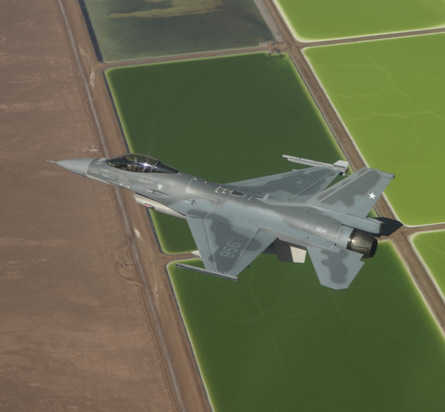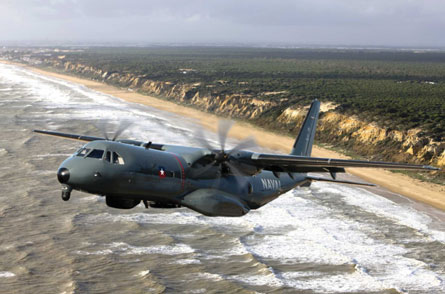Chile's aerospace industry is clearly at a crossroads. When about 400 aerospace companies from 40 countries descend on Santiago later this month for the sixteenth edition of the FIDAE air show, they will be meeting Chilean decision-makers less than four weeks after a devastating earthquake struck the country and only two weeks after the inauguration of the first right-wing president since the end of the Pinochet era.
The 27 February earthquake and 11 March change in power could result in a shift of priorities at the armed forces, which have significantly reduced new aircraft spending in recent years. "All the existing plans will be thrown back into the hat and they'll have to re-prioritise," predicts Lockheed Martin vice-president of international business development for the Americas Ron Covais.
Airbus Military head of commercial Ignacio Alonso adds: "I think Chile will come back to energise the market."
 |
|---|
© Lockheed MartinChile for now is pnly planning a cockpit upgrade for its ageing C-130 fleet |
Any increase in military aircraft spending could also benefit Chile's only sizeable aerospace company, government-owned Enaer, which has struggled during the current economic downturn. But do not expect any sudden changes in Chile's aerospace and defence priorities, as the new Sebastian Pinera administration is likely to take its time to get going and will need to focus initially on more pressing post-earthquake needs such as rebuilding roads and bridges. "Sooner or later they will come back. When they do we'll be there," says Alonso.
Alonso and Covias, both of whom have been working the Chilean market for more than two decades, recall the much busier FIDAE air shows of 2000, 2002 and 2004 when there were several active campaigns. But since 2006, when Chile took delivery of its new batch of 10 Lockheed F-16C/Ds and dropped plans to acquire three Airbus A400Ms, campaigns have been limited to much smaller aircraft acquisitions and relatively minor platform upgrades.
 |
|---|
© Lockheed MartinChile operates 10 new F-16C/Ds but it is in the process of adding older A/Bs |
Alonso says the slowdown in activity was driven not by economic problems but a shift in how military modernisation funds were managed, which resulted in Chile "becoming more prudent" in its spending. Previously each service had control over what they could spend with their budgets tied directly to copper sales. But in recent years the defence ministry became more involved, slowing the overall process of acquisitions, as part of an overhaul of the military finance system.
The change of administration could lead to more changes in the military finance system and possibly the return of big ticket purchases. "I think Chile could be a candidate for the A400M in the future. Sooner or later they will need more airlift capability. They have a need to go south," Alonso says, referring to Chile's mission in Antarctica.
Chile's airlift capability is now limited to three Lockheed C-130s along with several types of smaller aircraft, including about 10 transport configured EADS Casa C-212s and CN-235s spread across the air force, army and navy.

In an interview just before the earthquake, Chilean air force commander in chief Gen Ricardo Ortega Perrier told Flight International that the service is in the process of upgrading the cockpits in its C-130 fleet. The upgrade will extend the service lives of Chile's three C-130s and "for this reason" new transport aircraft are not being considered.
FUTURE AIRLIFT NEEDS
It is too early to tell if the air force, which after the 8.8 magnitude earthquake operated a 500km (270nm) air bridge from Santiago to the harder hit city of Concepcion, will now change its views. Airbus, however, is confident Chile will look again at the A400M in the long term, although Alonso "doesn't see a campaign in the next one to two years". Airbus Military also foresees requirements for more CN-235s and C-295s in Chile and throughout the region.
Airbus in December delivered the first of three C-295 maritime surveillance aircraft from a 2007 contract with the Chilean navy and the remaining two aircraft are now scheduled for delivery later this year. Before the earthquake struck, Chile was talking to Airbus about exercising some of the five options, which include one aircraft in transport configuration, included in the original deal. "We're in the progress of negotiations for more aircraft but with the current circumstances we may have to wait," Alonso says.
Latin America has historically been EADS Casa's strongest region outside Europe, with more than 100 aircraft in the C-212/235/295 family delivered to about 30 operators, including all three Chilean military services.
Chile was the first export customer for the aircraft outside the Iberian peninsula, with Chile's navy first receiving C-212s in the 1970s. Alonso credits the aircraft's success in the region to its flexibility in being configured for a wide variety of missions and its more affordable price tag compared with larger platforms such as the A400M, which is considered too expensive and big for every Latin American country except Chile, Brazil and Mexico.
REGIONAL REQUIREMENTS
There are several campaigns for CN-235s/C-295s in the region, which may further intensify following the aircraft's role in humanitarian operations in the aftermath of the Chile and Haiti earthquakes. "I think South America for the CN-235 and C-295 has a lot of potential," Alonso says.
While Lockheed expects Chile to look again at its priorities, the manufacturer does not expect the two earthquakes will lead to a major increase in interest in new military transports throughout the Latin America and Caribbean region.
Covais says that given the limited budgets in the region, "military requirements are driven more by modernisation rather than threat". He adds that "it's becoming precarious to continue operating" some of the ageing military aircraft in Latin America, especially in some Central American countries.
In Chile, Covais says that Lockheed over the past few years helped the air force "go through the calculus" of whether to upgrade its existing C-130s, sustain the current configuration or buy new or used aircraft. He expects once all the earthquake-related missions are completed, the air force will look at how its C-130 fleet performed and "will go back and review their own requirements".
Any expansion or upgrade to the C-130 fleet would be likely to benefit Enaer, the MRO provider for Chile's C-130s and occasionally other Latin American operators including Uruguay and Colombia. Enaer marketing manager Jorge Flores says the company has formed a joint venture with Canada's CMC under the air force's C-130 cockpit upgrade programme, with CMC providing the kit and technical assistance.
Enaer also has a big stake in the C-212/235/295 programme. Enaer manufactures part of the fuselage for the CN-235 and the larger C-295 in a supplier relationship that began with the CN-235 and C-101 30 years ago. Enaer says it delivered 22 CN-235 and C-295 fuselage sections to Airbus Military last year and expects to deliver 16 this year.

This has been Enaer's only stable programme over the past several months, given the dramatic slowdown of production for Embraer, its only other major customer for aircraft components following the termination of programmes for Eclipse Aviation and Dassault Falcon.
Enaer delivered only 10 vertical stabilisers and four vertical fin assemblies for the ERJ/Legacy family last year, commpared to about 50 of each in 2008. Enaer has been the empennage supplier for the ERJ since the programme was launched and at one point there was a requirement for 16 shipsets each month.
 |
|---|
© Airbus MilitaryChile's navy late in 2009 took delivery of the first of at least three C-295s |
Enaer, which has supplied Embraer with empennages for over 1,000 aircraft to date, expects to produce 20 vertical stabilisers and 20 vertical fin assemblies this year. Flores says "we're now talking to Embraer about future projects", which could help fill some of the Enaer's excess capacity.
Enaer was the nose supplier for the Eclipse 500 very light jet before the manufacturer was liquidated early last year. Flores says Enaer is now hoping for a resumption of Eclipse 500 production under the new owners. "The bankruptcy was very awful for us. Less demand from Embraer also has had a negative contribution," Flores says. "We've really been affected by the economic crisis."
Enaer was also supplier for the lower central fairing of the Falcon 900 and 2000 fuselage until last year. Flores says Enaer decided to end the project after 345 deliveries, explaining "we had a higher cost than Dassault wanted to pay".
ENAER'S CHALLENGE
Staying competitive could be a major challenge for Enaer going forward as Chile has higher labour costs than the rest of Latin America. Enaer has also struggled in the civilian MRO business as Chilean flag carrier LAN has moved to outsource an increasing portion of its maintenance to other Latin American countries. Enaer's civilian MRO business is now limited to 737 C check contracts with three customers - two Venezuelan carriers and a Paraguayan leasing company.
Enaer has about 1,000 employees, with roughly half on the MRO side, almost all of which is now military, and half involved in manufacturing. It has five maintenance hangars spread across two facilities at Santiago's commercial airport and the El Bosque air base south of the capital.
Covais says Enaer's manufacturing capability "is very limited" and one notch below the capabilities Lockheed developed at its former subsidiary in Argentina. Enaer began supplying Lockheed with small F-16 parts in 2006 as part of an offset requirement from Chile's F-16C/D purchase that Lockheed completed last year.
The US company says it now has with Enaer an "ongoing commercial contract for delivery of F-16 detail parts" and Enaer says it also now supplies Israel Aerospace Industries with military aircraft parts. But Corvais does not see Chile growing into a larger aerospace country given its small local market. "You can't develop infrastructure your own market can't support," he says. "Chile is just too small."
Alonso says that while Chile has not followed other Latin American governments such as Brazil and Mexico in advocating fast expansion of aerospace capabilities he says Enaer has "good knowledge" and "has been a good supplier for us". He adds "the relationship with them has never been linked to a specific campaign" and Airbus Military's commercial supplier relationship with Enaer is expected to continue.
future of the pillan in doubt
While Enaer's future as a manufacturer should be assured even if Chile remains a very small player in the global aerospace supply chain, the company's dreams of one day again producing entire aircraft are less likely to be realised. Enaer manufactured 112 T-35 Pillans but has not produced any in six years despite numerous attempts to revive interest in an updated version of the basic trainer. It continues to support the Pillan, which is operated in Chile and other countries in Latin America and the Caribbean.
At FIDAE in 2008 Enaer launched a tie-up with Alenia Aermacchi envisaging marketing and possible local production of the M-346 and M-311 trainers. But the air force later in 2008 ordered 12 Embraer EMB-312 Super Tucanos, all of which were recently delivered, and is no longer looking at acquiring other types of trainers.
Ortega says the air force has no plans to replace its C-101 trainers until at least 2018 and "at this moment we don't have plans to replace or upgrade" its Pillan fleet.
The air force is also not planning any upgrade to its fighter fleet. Instead of acquiring more new fighters, Chile has opted to acquire 18 used F-16A/Bs from the Netherlands. Ortega says the last of these fighters is scheduled to be delivered in December and for at least the next few years there will be no structural or avionics upgrades to bring them up to a specification closer to its F-16C/Ds.
"We took the decision for now to keep the configurations which they were acquired in, anticipating some level of standardisation in 2015," Ortega says.
Source: Flight International



















